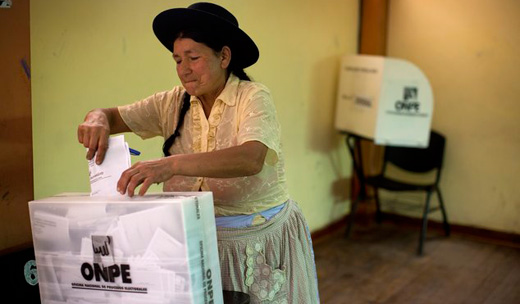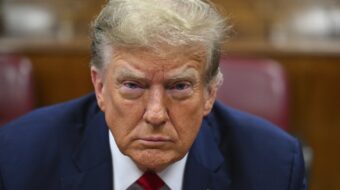
Peruvian voters will be heading back to the polls June 5 to cast their ballots in a presidential runoff after no candidate won a majority in general elections held April 10. Their unenviable task will be to choose from among two right-wingers, as the candidate of the leftist Broad Front, Verónika Mendoza, came in third during the first round of voting and will not advance to the runoff.
The April vote was held under conditions of instability and confusion. Just before polling, it had appeared that Mendoza might be facing off against right-winger Keiko Fujimori of the Popular Force Party. But in the end, another right-winger, Pedro Pablo Kuczynski of Peruvians for Change, beat out Mendoza by a small margin.
The number of candidates who originally filed for the presidential election was an amazing 14, of whom 10 made it through to election day. The process of qualifying and disqualifying candidates was extremely rough, and was denounced as arbitrary by the Secretary General of the Organization of American States, Luis Almagro.
Most notably, two candidates who appeared at one point to have considerable support, Julio Guzmán of the All for Peru party was disqualified by election authorities who took issue with the way his party had nominated him. Another, César Acuña, was kicked off the ballot because of accusations of vote buying, even though Keiko Fujimori was accused of exactly the same thing and was not disqualified.
The dictator’s daughter
Fujimori is the daughter of former dictator, Alberto Fujimori, who is still imprisoned for crimes against humanity and acts of corruption that took place when he was president from 1990 to 1992 and again from 1995 to 2000. His 25-year jail sentence was partly based on evidence that death squads organized by his government had massacred civilians in two specific incidents during his first term, at Barrios Altos and La Cantuta.
Most of the crimes committed by Fujimori and his cronies were against poor and indigenous communities, under the pretext of suppressing the violent Maoist “Shining Path” (Sendero Luminoso) guerrilla group. The Ayacucho region of Southern Peru, where most people are native speakers of Quechua, the language of the ancient Incas, was the focus of most of Shining Path’s attacks and thus also suffered the brunt of the Fujimori-era repression.
A strong minority of Peruvians have good memories, though, of the Fujimori regime, which they perceive as having crushed the terrorist danger and stabilized the economy. They make up a significant share of the voting base his daughter relies on today.
However, other Peruvians – some believe the majority – think of Keiko Fujimori as a potential fascist dictator herself, and are inclined not to believe her claims that, if elected president, she will rule differently and will not even release her father from jail.
Runoff locks out the left
Toward the end of the campaign, it became clear that Fujimori would win the most votes but not the 50 percent that would have allowed her to avoid a runoff. So the big question became who would face her in the final contest.
Polls showed a close race for the number two position between Kuczynski, who had been prime minister from 2005 to 2006 (Peru has both a president and a prime minister), and the Broad Front’s Mendoza, who is a member of the Peruvian Congress for the Cuzco area.
Her party, the Broad Front, or Frente Amplio in Spanish, represents a coming together of several different socialist and leftist groups, including both of Peru’s existing communist parties (Partido Comunista Peruano and Partido Comunista del Peru-Patria Roja), and other organizations. Its platform calls for the democratization of all aspects of the Peruvian economy and society.
Two former presidents of Peru who were trying to re-win the presidency, Alejandro Toledo (2001 to 2006) of Possible Peru, and Alan García (1985 to 1990 and 2006 to 2011) of the Popular Alliance, found themselves far behind in polling and did not make it to the runoff.
With the exception of Mendoza, all the candidates could be considered right-wing or right-center.
As the campaign progressed, Mendoza’s numbers began to rise. The right tried to combat this by red-baiting her with vague references to the Shining Path (with which Mendoza has no connection), and by questioning her loyalty to Peru because her mother was born in France. The right also tried to appeal to conservative Catholics and Evangelicals by attacking Menedoza’s progressive views human sexuality.
Just as the campaign neared its end, the scandal of the Panama Papers suddenly became a possible factor in Mendoza’s favor. Of the three top candidates (Fujimori, Kuczynski, and Mendoza), she was the only one whose name had not cropped up in that vast data trove.
Mendoza’s rise was not quite big enough, however, to put her into the runoff against Fujimori. Semi-final electoral tallies show that Fujimori received 5,767,797 votes, or 39.74 percent, while Kuczynski got 3,054,281 or 21.04 percent. Mendoza won 2,727,874 votes, or 18.79 percent.
The geographical, economic, and ethnic spread of the vote was revealing. Mendoza’s leftist campaign performed very well in most of Southern Peru, especially in the Ayacucho, Apurímac, Cuzco, Huancavelica, Puno, Moquegua, and Tacna regions. Cuzco is Mendoza’s hometown which she has represented in Congress, so the wide margin there is no surprise.
Ayacucho is the area that was hardest hit by the Sendero Luminoso violence and by the government repression that ensued. Most of these regions have a high concentration of native speakers of indigenous languages, in comparison with the rest of the country which is 86 percent Spanish speaking, and most of them are relatively poor. This shows that, as in other countries in the region, the left’s message of social justice still resonates among important sectors of the population.
A contest of the right
So the runoff will be between two right-wingers: Fujimori, with her “law and order” stance and the baggage of her father’s sinister regime, and Kuczynski, who is seen as one of the candidates closest to international monopoly capital and a promoter of neoliberal economic policies of free trade, privatization, and deregulation.
If Fujimori emerges victorious, she will enjoy the support of the biggest bloc in Congress, as her party took 68 of the 130 seats. But if it is Kuczynski, he will only be able to count on the 20 seats won by his Peruvians for Change party – the same number won by the Broad Front.
No matter which of the two wins the runoff, election represents a major gain for the ultra-right compared to the results of 2011. Then, left-wing candidate Ollanta Humala and his alliance won both the presidency and the highest number of Congressional seats. Due to constitutional term limits, he was unable to run for re-election. However, Humala quickly disappointed his supporters by imposing the same neo-liberal policies that he had criticized as a candidate.
The good news is that Mendoza’s showing is better than that of any openly socialist candidate in recent presidential elections.
With the left shut out, the only possible outcome this time is a right-wing administration. Forced to pick their poison, the Peruvian people face foreboding times ahead.
Photo: Rodrigo Abd/AP












Comments